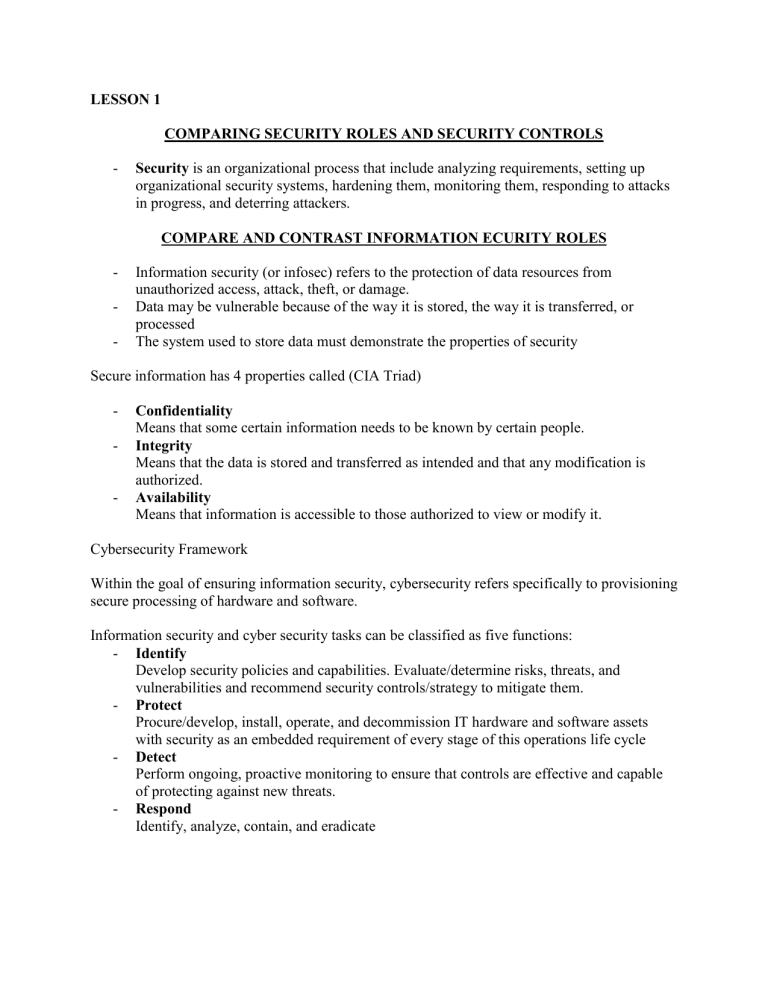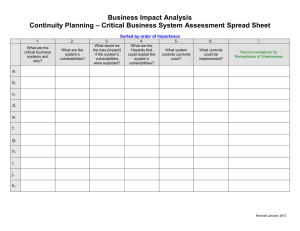
LESSON 1 COMPARING SECURITY ROLES AND SECURITY CONTROLS - Security is an organizational process that include analyzing requirements, setting up organizational security systems, hardening them, monitoring them, responding to attacks in progress, and deterring attackers. COMPARE AND CONTRAST INFORMATION ECURITY ROLES - Information security (or infosec) refers to the protection of data resources from unauthorized access, attack, theft, or damage. Data may be vulnerable because of the way it is stored, the way it is transferred, or processed The system used to store data must demonstrate the properties of security Secure information has 4 properties called (CIA Triad) - - Confidentiality Means that some certain information needs to be known by certain people. Integrity Means that the data is stored and transferred as intended and that any modification is authorized. Availability Means that information is accessible to those authorized to view or modify it. Cybersecurity Framework Within the goal of ensuring information security, cybersecurity refers specifically to provisioning secure processing of hardware and software. Information security and cyber security tasks can be classified as five functions: - Identify Develop security policies and capabilities. Evaluate/determine risks, threats, and vulnerabilities and recommend security controls/strategy to mitigate them. - Protect Procure/develop, install, operate, and decommission IT hardware and software assets with security as an embedded requirement of every stage of this operations life cycle - Detect Perform ongoing, proactive monitoring to ensure that controls are effective and capable of protecting against new threats. - Respond Identify, analyze, contain, and eradicate LESSON 2 Lesson Introduction In order to make an effective security assessment, you should be able to explain strategies for both defense and attack. LESSON 3 Performing security assessments - Security assessments refers to a process and tools that evaluate the attack surface. The purpose of the security assessment is for deploying, enhancing, or reconfiguring security controls to mitigate risks. TOPIC 3A Assess organizational security with network reconnaissance tool Reconnaissance - Is a type of assessment activity that maps the potential attack surface by identifying the nodes and connection that makes up the network - You’ll often need to run scans using both command-line interface and GUI topology discovery tools - You should also understand how tools can be used to operate backdoor connection to a host and to covertly exfiltrate data. Ipconfig, ping, and arp - The process of doing the mapping on the attack surface is referred to as network reconnaissance and discovery. Reconnaissance techniques are used by threat actors, but they are also used by security professionals to test their own security systems, as part of security assessment and ongoing monitoring. - Topology discovery ( or “footprinting”) means scanning for hosts, IP ranges, and routes between netowrks to map out the structure of the target network. - Topology discovery can also be used to build an asset database and to identify nonauthorized hosts (rogue system detection) or network configuration errors. The following tools report the IP configuration and test connectivity on the local network segment or subnet Ipconfig - shows the configuration assigned to network interface(s) in windows, including the hardware or Media Access Control (MAC) address, IPv4 and IPv6 addresses, default gateway, and whether the address is static or assigned by DHCP. - If the address is DHCP assigned, the output also shows the address of the DHCP server that provided the lease. Ifconfig – show the configuration assigned to network interface(s) in Linux ping – probe a host a particular IP address or host name using Internet Control Message Protocol (ICMP). - You can use ping for a simple script to perform a sweep of all the IP addresses in a subnet. The following example will scan the 10.1.0.0/24 subnet from a windows machine: For /1 %i in (1,1,255) do @ ping –n 1 –w 100 10.1.0.%i | find /i “reply” TOPIC 3D Explain Penetration Testing Concepts Vulnerability Scanning does not determine what a threat actor might be able to achieve. Penetration Testing is a type of assessment that use known tactics and techniques to attempt intrusions (Actions). Devising, planning and leading is a specialized security role. Penetration test – often shortened to pen test. Penetration test uses authorized hacking techniques to discover exploitable weaknesses in the target’s security system. Pen test is also referred to as Ethicalhacking. You can perform security checks or penetration test by referring to one of these techniques. Verify a threat exist, Bypass security controls, Actively test security controls, and exploits vulnerabilities. Verify threat exists – use surveillance, social engineering, network scanners, and vulnerability assessment tools to identify a vector by which vulnerabilities that could be exploited. Networking and computer surveillance is the process of monitoring the computer systems by keeping an eye on the activities done on the computers or data being transferred over the network(such as internet). Bypass security controls – to bypass security controls, this where we look for the easy way to break into the system. Example: If the network is protected by the firewall, it is possible to gain physical access to a computer in the building and run malware from a USB stick? Actively test security controls – Review security controls by checking configuration weaknesses and errors such as weak passwords or software vulnerabilities. Exploit vulnerabilities – Here a security expert proves that a system has some weaknesses, by exploiting it to gain access to data or install back-door. Rules of Engagement Security controls might be done by employees or may be done by a third party or a by consultant. Rules of Engagement provide details on what activity needs to be done and what is permitted under that activity and what is prohibited. A pen test should have a scope to follow while doing it. Attack Profile Attacks comes in different forms. You may need or wish to perform your network scan from the external part of your network or from the inside (External and Insider Threats). Attack Profiling is the method used to determine actions of an attacker, sharing threat Intelligence and preparing necessary tools for the exploits that might happen in future. Blackbox (or unknown environment) – This is where a consultant is given no privileged information about the network and its security systems. Blackbox I Threat intelligence – Threat intelligence (Information) refers to the information that has been found, analyzed, interpreted to provide necessary ideas on how to act or make a decision based on the system insecurities. LESSON 5 Summarizing Basic Cryptographic Concepts A cryptographic system encode data in such a way that only authorized person can decode it. Compare and Contrast Cryptographic Ciphers - A cipher is a particular operation or process made to encode or decode data. Cryptographic systems use symmetric and asymmetric cipher types to encode or decode data. As well as these cipher types, one-way hash function have an important role to play in many security controls. The one-way hash function cipher type plays an important role in many security controls. Cryptographic concepts - Cryptography (literally meaning “secret writing”). Cryptography is the art of protecting or keeping data secure by encoding it. This stands in opposition to the concept of security through obscurity. Security through obscurity means keeping something a secret by hiding it. The concept Security through obscurity states that a system can stay secure if the vulnerabilities of a system are kept as a secret or hidden. An attacker can exploit the system if h or she does not know the weaknesses. The flipped side is that what if the vulnerabilities are exposed, it is no longer secure. Security through obscurity is considered as high risk strategy on any sort of computer network. The following terminology is used to discuss cryptography: Plaintext (or cleartext) – an unencrypted message Ciphertext - is an encrypted message Cipher – is the process used to encrypt and decrypt a message. Cryptanalist – is the art of cracking cryptographic systems In discussing cryptography and attacks against encryption systems, it is customary to use a cast of characters to describe different actors involved in the process of an attack. The main characters are: Alice – The sender of a signature message Bob – The intended recipient of the message Mallory – a malicious attacker attempting to subvert (destroy or damage) the message in some way. There are three main types of algorithm with different roles to play in the assurance of security properties confidentiality, integrity, availability, and non-repudiation. These types are hashing algorithms and two types of encryption ciphers: symmetric and asymmetric. Hashing Algorithms




